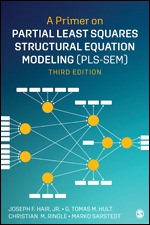A Primer on Partial Least Squares Structural Equation Modeling (PLS-SEM)
Third Edition
- Joseph F. Hair, Jr. - University of South Alabama, USA
- G. Tomas M. Hult - Michigan State University, USA
- Christian M. Ringle - Hamburg University of Technology, Germany
- Marko Sarstedt - Ludwig-Maximilians-University, Munich, Germany, Babes-Bolyai University, Romania
July 2021 | 384 pages | SAGE Publications, Inc
The third edition of A Primer on Partial Least Squares Structural Equation Modeling (PLS-SEM) guides readers through learning and mastering the techniques of this approach in clear language. Authors Joseph H. Hair, Jr., G. Tomas M. Hult, Christian Ringle, and Marko Sarstedt use their years of conducting and teaching research to communicate the fundamentals of PLS-SEM in straightforward language to explain the details of this method, with limited emphasis on equations and symbols. A running case study on corporate reputation follows the different steps in this technique so readers can better understand the research applications. Learning objectives, review and critical thinking questions, and key terms help readers cement their knowledge. This edition has been thoroughly updated, featuring the latest version of the popular software package SmartPLS 3. New topics have been added throughout the text, including a thoroughly revised and extended chapter on mediation, recent research on the foundations of PLS-SEM, detailed descriptions of research summarizing the advantages as well as limitations of PLS-SEM, and extended coverage of advanced concepts and methods, such as out-of-sample versus in-sample prediction metrics, higher-order constructs, multigroup analysis, necessary condition analysis, and endogeneity.
Preface
About the Authors
Chapter 1. An Introduction to Structural Equation Modeling
Chapter 2. Specifying the Path Model and Examining Data
Chapter 3. Path Model Estimation
Chapter 4. Assessing PLS-SEM Results—Part I: Evaluation of the Reflective Measurement Models
Chapter 5. Assessing PLS-SEM Results—Part II: Evaluation of the Formative Measurement Models
Chapter 6. Assessing PLS-SEM Results—Part III: Evaluation of the Structural Model
Chapter 7. Mediator and Moderator Analysis
Chapter 8. Outlook on Advanced Methods
Glossary
References
Index
This book provides my course with details guideline for analysis in the latest PLS-SEM research and my students can understand it well
Education, Universitas Muhammadiyah Surakarta
February 25, 2023

